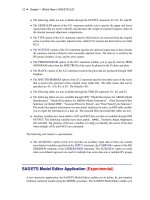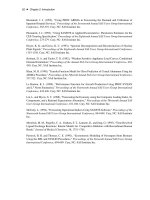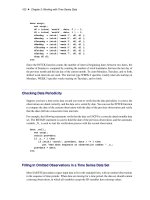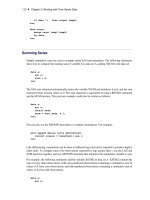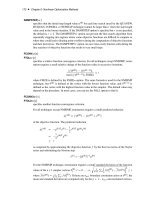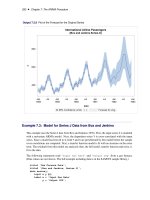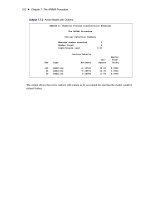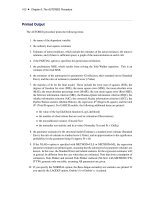SAS/ETS 9.22 User''''s Guide 72 ppt
Bạn đang xem bản rút gọn của tài liệu. Xem và tải ngay bản đầy đủ của tài liệu tại đây (267.46 KB, 10 trang )
702 ✦ Chapter 12: The ENTROPY Procedure (Experimental)
The standard maximum likelihood approach for multinomial logit is equivalent to the maximum
entropy solution for discrete choice models. The generalized maximum entropy approach avoids an
assumption of the form of the link function G./.
The generalized maximum entropy for discrete choice models (GME-D) is written in primal form as
maximize H.p; w/ D p
0
ln.p/ w
0
ln.w/
subject to .I
j
˝ X
0
y/ D .I
j
˝ X
0
/p C .I
j
˝ X
0
/V w
P
k
j
p
ij
D 1 for i D 1 to N
P
L
m
w
ijm
D 1 for i D 1 to N and j D 1 to k
Golan, Judge, and Miller (1996) have shown that the dual unconstrained formulation of the GME-
D can be viewed as a general class of logit models. Additionally, as the sample size increases,
the solution of the dual problem approaches the maximum likelihood solution. Because of these
characteristics, only the dual approach is available for the GME-D estimation method.
The parameters
ˇ
j
are the Lagrange multipliers of the constraints. The covariance matrix of the
parameter estimates is computed as the inverse of the Hessian of the dual form of the objective
function.
Censored or Truncated Dependent Variables
In practice, you might find that variables are not always measured throughout their natural ranges.
A given variable might be recorded continuously in a range, but, outside of that range, only the
endpoint is denoted. In other words, say that the data generating process is:
y
i
D x
i
˛ C :
However, you observe the following:
y
?
i
D
8
<
:
ub W y
i
ub
x
i
˛ C W lb < y
i
< ub
lb W y
i
Ä lb
The primal problem is simply a slight modification of the primal formulation for GME-GCE. You
specify different supports for the errors in the truncated or censored region, perhaps reflecting some
nonsample information. Then the data constraints are modified. The constraints that arise in the
censored areas are changed to inequality constraints (Golan, Judge, and Perloff 1997). Let the
variable
X
u
denote the observations of the explanatory variable where censoring occurs from the top,
X
l
from the bottom, and
X
a
in the middle region (no censoring). Let,
V
u
be the supports for the
observations at the upper bound, V
l
lower bound, and V
a
in the middle.
You have:
2
4
y
u
ub
y
a
y
l
Ä lb
3
5
D
2
4
X
u
X
a
X
l
3
5
Zp C
2
4
V
u
w
u
V
a
w
a
V
l
w
l
3
5
Information Measures ✦ 703
The primal problem then becomes
maximize H.p; w/ D p
0
ln.p/ w
0
ln.w/
subject to y
a
D X
a
V
a
p C V
a
w
a
y
u
X
u
V
u
p C V
u
w
u
y
l
Ä X
l
V
l
p C V
l
w
l
1
K
D .I
K
˝ 1
0
L
/ p
1
T
D .I
T
˝ 1
0
L
/ w
PROC ENTROPY requires that the number of supports be identical for all three regions.
Alternatively, you can think of cases where the dependent variable is observed continuously for most
of its range. However, the variable’s range is reported for some observations. Such data is often
found in highly disaggregated state level employment measures.
y
?
i
D
8
ˆ
ˆ
ˆ
<
ˆ
ˆ
ˆ
:
missing W l
1
Ä y Ä r
1
:
:
: W
:
:
:
missing W l
k
Ä y Ä r
k
x
i
˛ C W otherwise
Just as in the censored case, each range yields two inequality constraints for each observation in that
range.
Information Measures
PROC ENTROPY returns several measures of fit. First, the value of the objective function is returned.
Next, the signal entropy is provided followed by the noise entropy. The sum of the noise and signal
entropies should equal the value of the objective function. The next two metrics that follow are the
normed entropies of both the signal and the noise.
Normalized entropy (NE) measures the relative informational content of both the signal and noise
components through p and w, respectively (Golan, Judge, and Miller 1996). Let S denote the
normalized entropy of the signal, Xˇ, defined as:
S. Qp/ D
Qp
0
ln. Qp/
q
0
ln.q/
where S. Qp/ Œ0; 1. In the case of GME, where uniform priors are assumed, S can be written as:
S. Qp/ D
Qp
0
ln. Qp/
P
i
ln.M
i
/
where
M
i
is the number of support points for parameter
i
. A value of 0 for S implies that there is
no uncertainty regarding the parameters; hence, it is a degenerate situation. However, a value of 1
704 ✦ Chapter 12: The ENTROPY Procedure (Experimental)
implies that the posterior distributions equal the priors, which indicates total uncertainty if the priors
are uniform.
Because NE is relative, it can be used for comparing various situations. Consider adding a data
point to the model. If
S
T C1
D S
T
, then there is no additional information contained within that
data constraint. However, if
S
T C1
< S
T
, then the data point gives a more informed set of parameter
estimates.
NE can be used for determining the importance of particular variables with regard to the reduction of
the uncertainty they bring to the model. Each of the
k
parameters that is estimated has an associated
NE defined as
S. Qp
k
/ D
Qp
0
k
ln. Qp
k
/
ln.q
k
/
or, in the GME case,
S. Qp
k
/ D
Qp
0
k
ln. Qp
k
/
ln.M /
where
Qp
k
is the vector of supports for parameter
ˇ
k
and
M
is the corresponding number of support
points. Since a value of 1 implies no relative information for that particular sample, Golan, Judge,
and Miller (1996) suggest an exclusion criteria of
S. Qp
k
/ > 0:99
as an acceptable means of selecting
noninformative variables. See Golan, Judge, and Miller (1996) for some simulation results.
The final set of measures of fit are the parameter information index and error information index.
These measures can be best summarized as 1 – the appropriate normed entropy.
Parameter Covariance For GCE
For the cross-entropy problem, the estimate of the asymptotic variance of the signal parameter is
given by:
O
Var.
O
ˇ/ D
O
2
.
O
ˇ/
O
2
.
O
ˇ/
.X
0
X/
1
where
O
2
.
O
ˇ/ D
1
N
N
X
iD1
2
i
and
i
is the Lagrange multiplier associated with the i th row of the V w constraint matrix. Also,
O
2
.
O
ˇ/ D
2
6
4
1
N
N
X
iD1
0
@
J
X
j D1
v
2
ij
w
ij
.
J
X
j D1
v
ij
w
ij
/
2
1
A
1
3
7
5
2
Parameter Covariance For GCE-NM ✦ 705
Parameter Covariance For GCE-NM
Golan, Judge, and Miller (1996) give the finite approximation to the asymptotic variance matrix of
the normed moment formulation as:
O
Var.
O
ˇ/ D †
z
X
0
XC
1
DC
1
X
0
X†
z
where
C D X
0
X†
z
X
0
X C †
v
and
D D X
0
†
e
X
Recall that in the normed moment formulation,
V
is the support of
X
0
e
T
, which implies that
†
v
is a
K-dimensional variance matrix. †
z
and †
v
are both diagonal matrices with the form
†
z
D
2
6
4
P
L
lD1
z
2
1l
p
1l
.
P
L
lD1
z
1l
p
1l
/
2
0 0
0
:
:
:
0
0 0
P
L
lD1
z
2
Kl
p
Kl
.
P
L
lD1
z
Kl
p
Kl
/
2
3
7
5
and
†
v
D
2
6
4
P
J
j D1
v
2
1j
w
jl
.
P
J
j D1
v
1j
w
1j
/
2
0 0
0
:
:
:
0
0 0
P
J
j D1
v
2
Kl
w
Kl
.
P
J
j D1
v
Kl
w
Kl
/
2
3
7
5
Statistical Tests
Since the GME estimates have been shown to be asymptotically normally distributed, the classical
Wald, Lagrange mulitiplier, and likelihood ratio statistics can be used for testing linear restrictions
on the parameters.
Wald Tests
Let
H
0
W Lˇ D m
, where
L
is a set of linearly independent combinations of the elements of
ˇ
. Then
under the null hypothesis, the Wald test statistic,
T
W
D .Lˇ m/
0
L.
O
Var.
O
ˇ//L
0
Á
1
.Lˇ m/
has a central
2
limiting distribution with degrees of freedom equal to the rank of L.
706 ✦ Chapter 12: The ENTROPY Procedure (Experimental)
Pseudo-Likelihood Ratio Tests
Using the conditionally maximized entropy function as a pseudo-likelihood,
F
, Mittelhammer and
Cardell (2000) state that:
2
O
.
O
ˇ/
O
2
.
O
ˇ/
F .
O
ˇ/ F .
Q
ˇ/
Á
has the limiting distribution of the Wald statistic when testing the same hypothesis. Note that
F .
O
ˇ/
and
F .
Q
ˇ/
are the maximum values of the entropy objective function over the full and restricted
parameter spaces, respectively.
Lagrange Multiplier Tests
Again using the GME function as a pseudo-likelihood, Mittelhammer and Cardell (2000) define the
Lagrange multiplier statistic as:
1
O
2
.
Q
ˇ/
G.
Q
ˇ/
0
.X
0
X/
1
G.
Q
ˇ/
where
G
is the gradient of
F
, which is being evaluated at the optimum point for the restricted
parameters. This test statistic shares the same limiting distribution as the Wald and pseudo-likelihood
ratio tests.
Missing Values
If an observation in the input data set contains a missing value for any of the regressors or dependent
values, that observation is dropped from the analysis.
Input Data Sets ✦ 707
Input Data Sets
DATA= Data Set
The DATA= data set specified in the PROC ENTROPY statement is the data set that contains the
data to be analyzed.
PDATA= Data Set
The PDATA= data set specified in the PROC ENTROPY statement specifies the support points and
prior probabilities to be used in the estimation. The PDATA= can be used in lieu of a PRIORS
statement, but is intended for use in conjunction with the OUTP= option. Once priors are entered
through a PRIORS statement, they can be reused in subsequent estimations by specifying the
PDATA= option.
The variables in the data set are as follows:
BY variables (if any)
_TYPE_, a character variable of length 8 that identifies the estimation method: GME or
GMENM. This is an optional column.
variable, a character variable of length 32 that indicates the name of the regressor. The
regressor name and the equation name identify a unique coefficient. This is required.
_OBS_, a numeric variable that is either missing when the probabilities are for coefficients
or the observation number when the probabilities are for the residual terms. The _OBS_ and
the equation name identify which residual the probability is associated with. This an optional
column.
equation, a character variable of length 32 indicating the name of the dependent variable. This
is a required column.
NSupport, a numeric variable that indicates the number of support points for each basis. This
variable is required.
support, a numeric variable that is the support value the probability is associated with. This is
a required column.
prior, a numeric variable that is the prior probability associated with the probability. This is a
required column.
Prb, a numeric variable that is the estimated probability. This is optional.
708 ✦ Chapter 12: The ENTROPY Procedure (Experimental)
SDATA= Data Set
The SDATA= data set specifies a data set that provides the covariance matrix of the equation errors.
The matrix read from the SDATA= data set is used for the equation covariance matrix (
S
matrix)
in the estimation. (The SDATA=
S
matrix is used to provide only the initial estimate of
S
for the
methods that iterate the S matrix.)
Output Data Sets
OUT= Data Set
The OUT= data set specified in the PROC ENTROPY statement contains residuals of the dependent
variables computed from the parameter estimates. The ID and BY variables are also added to this
data set.
OUTEST= Data Set
The OUTEST= data set contains parameter estimates and, if requested via the COVOUT option,
estimates of the covariance of the parameter estimates.
The variables in the data set are as follows:
BY variables
_NAME_, a character variable of length 32, blank for observations that contain parameter
estimates or a parameter name for observations that contain covariances
_TYPE_, a character variable of length 8 that identifies the estimation method: GME or
GMENM
the parameters estimated
If the COVOUT option is specified, an additional observation is written for each row of the estimate
of the covariance matrix of parameter estimates, with the _NAME_ values containing the parameter
names for the rows.
OUTP= Data Set
The OUTP= data set specified in the PROC ENTROPY statement contains the probabilities estimated
for each support point, as well as the support points and prior probabilities used in the estimation.
The variables in the data set are as follows:
BY variables (if any)
ODS Table Names ✦ 709
_TYPE_, a character variable of length 8 that identifies the estimation method: GME or
GMENM.
variable, a character variable of length 32 that indicates the name of the regressor. The
regressor name and the equation name identify a unique coefficient.
_OBS_, a numeric variable that is either missing when the probabilities are for coefficients or
the observation number when the probabilities are for the residual terms. The _OBS_ and the
equation name identify which residual the probability is associated with.
equation, a character variable of length 32 that indicates the name of the dependent variable
NSupport, a numeric variable that indicates the number of support points for each basis
support, a numeric variable that is the support value the probability is associated with
prior, a numeric variable that is the prior probability associated with the probability
Prb, a numeric variable that is the estimated probability
OUTL= Data Set
The OUTL= data set specified in the PROC ENTROPY statement contains the Lagrange multiplier
values for the underlying maximum entropy problem.
The variables in the data set are as follows:
BY variables
equation, a character variable of length 32 that indicates the name of the dependent variable
variable, a character variable of length 32 that indicates the name of the regressor. The
regressor name and the equation name identify a unique coefficient.
_OBS_, a numeric variable that is either missing when the probabilities are for coefficients or
the observation number when the probabilities are for the residual terms. The _OBS_ and the
equation name identify which residual the Lagrange multiplier is associated with
LagrangeMult, a numeric variable that contains the Lagrange multipliers
ODS Table Names
PROC ENTROPY assigns a name to each table it creates. You can use these names to reference
the table when using the Output Delivery System (ODS) to select tables and create output data sets.
These names are listed in the following table.
710 ✦ Chapter 12: The ENTROPY Procedure (Experimental)
Table 12.2 ODS Tables Produced in PROC ENTROPY
ODS Table Name Description Option
ConvCrit Convergence criteria for estimation default
ConvergenceStatus Convergence status default
DatasetOptions Data sets used default
MinSummary Number of parameters, estimation kind default
ObsUsed Observations read, used, and missing default
ParameterEstimates Parameter estimates default
ResidSummary Summary of the SSE, MSE for the equations default
TestResults Test statement table TEST statement
ODS Graphics
This section describes the use of ODS for creating graphics with the ENTROPY procedure.
ODS Graph Names
PROC ENTROPY assigns a name to each graph it creates using ODS. You can use these names to
reference the graphs when using ODS. The names are listed in Table 12.3.
To request these graphs, you must specify the ODS GRAPHICS statement.
Table 12.3 ODS Graphics Produced by PROC ENTROPY
ODS Graph Name Plot Description
DiagnosticsPanel Includes all the plots listed below
FitPlot Predicted versus actual plot
CooksD Cook’s D plot
QQPlot Q-Q plot of residuals
StudentResidualPlot Studentized residual plot
ResidualHistogram Histogram of the residuals
Examples: ENTROPY Procedure ✦ 711
Examples: ENTROPY Procedure
Example 12.1: Nonnormal Error Estimation
This example illustrates the difference between GME-NM and GME. One of the basic assumptions
of OLS estimation is that the errors in the estimation are normally distributed. If this assumption is
violated, the estimated parameters are biased. For GME-NM, the story is similar. If the first moment
of the distribution of the errors and a scale factor cannot be used to describe the distribution, then the
parameter estimates from GME-MN are more biased. GME is much less sensitive to the underlying
distribution of the errors than GME-NM.
To illustrate this, data for the following model is simulated with three different error distributions:
y D a x
1
C b x
2
C :
For the first simulation,
is distributed normally, then a chi-squared distribution with six degrees of
freedom is assumed for the second simulation, and finally
is assumed to have a Cauchy distribution
in the third simulation.
In each of the three simulations, 100 samples of 10 observations each were simulated. The data for
the model with the Cauchy error distribution is generated using the following DATA step code:
data one;
call streaminit(156789);
do by = 1 to 100;
do x2 = 1 to 10;
x1 = 10
*
ranuni( 512);
y = x1 + 2
*
x2 + rand('cauchy');
output;
end;
end;
run;
The statements for the other distributions are identical except for the argument to the RAND()
function.
The parameters to the model were estimated by using maximum entropy with the following program-
ming statements:
proc entropy data=one gme outest=parm1;
model y = x1 x2;
by by;
run;
The estimation by using moment-constrained maximum entropy was performed by changing the
GME option to GMENM. For comparison, the same model was estimated by using OLS with the
following PROC REG statements:

